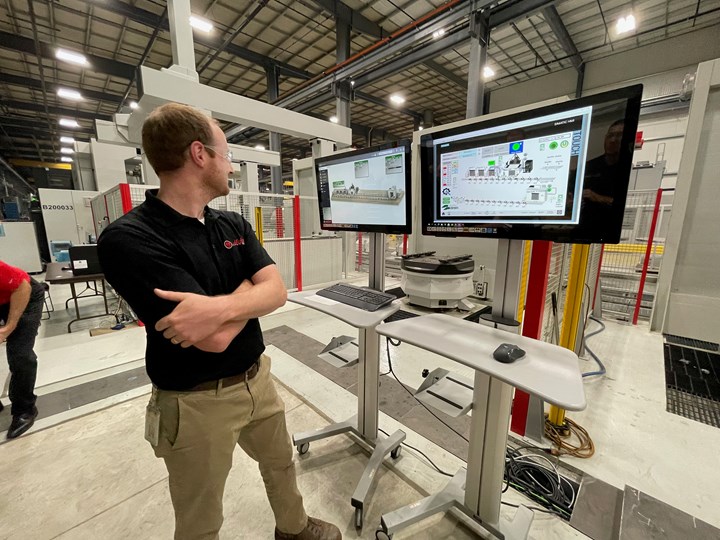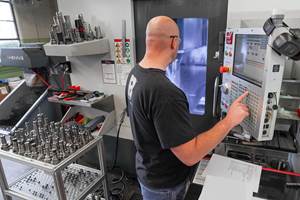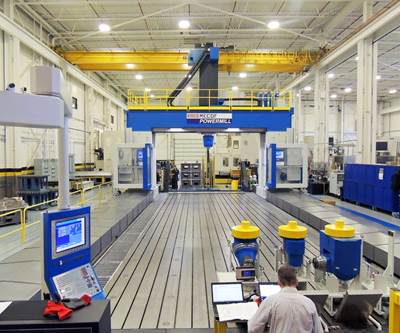Share


Major Tool’s Parpas XS 10.4, the smaller of the company’s two large-format high speed machining centers. Both maintain a high degree of accuracy via air-cooled internal components. Photo Credit: Tim Schumm, Major Tool
When it comes to the dimensional and weight limitations of the parts it produces, Major Tool & Machine is constrained only by the size of its bay doors. That, and the legal weight limits for travel across America’s highways.
The company, founded in 1946 to support the commercialization of the jet engine following World War II, is staffed with 415 employees working across a 620,000 square foot campus near downtown Indianapolis. CEO Steve Weyreter previously led the company, which operated as a family-owned business until its recent purchase by Precinmac, a diversified manufacturer of high-precision machined components and assemblies in the aerospace and defense, semiconductor, medical, and general industrials sectors. Major Tool’s capabilities align closely with its new parent company, and are distinct from most American machine shops in one key way: Major Tool’s large-format machining capabilities set it apart from all but a handful of contract manufacturers in the United States.
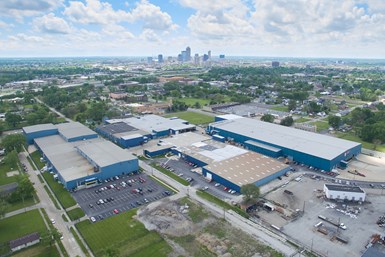
An aerial view of Major Tool's campus, located near downtown Indianapolis. Photo Credit: Major Tool
Everything here, from the machine tools to the buildings that house them — not to mention the ambition of the company itself — feels large and imposing. I recently visited the company to learn about its challenges today on the occasion of its 75th anniversary year. Even some of the stories I heard about the company’s recent history, like the time company leadership had to convince local government to allow Major Tool to purchase an adjacent road for the ingress/egress of its trucks, are big and sprawling.
But even though Major Tool’s five plants are packed with state-of-the-art equipment, including more than 40 CNC machine tools with several that boast X-axis travel capabilities of more than 60 feet, the company's core challenges include one that many American machine shops will recognize.
Of course, that challenge is people.
Skilled workers — the lack of whom arguably form the biggest hurdle facing U.S. manufacturing today — are as hard to recruit to a perks-galore company like Major Tool as they are almost anywhere. This shortfall is leading machining businesses to confront the problem through automation. Major Tool is doing the same.
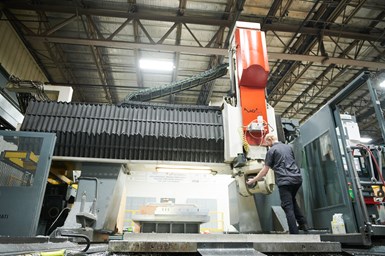
One of several large-format high speed machining centers at Major Tool — this one a Fives Cincinnati U5 gantry mill. Photo Credit: Tim Schumm, Major Tool
Investment in technologies like adaptive-control machining, which we will come to later, is a big part of its strategy. The company’s most significant recent capital investment is an automated machining line featuring a pallet system and large machining centers from Parpas that brings lights-out machining (including inspection on a CMM that is also part of the system) to large workpieces.
However, for a manufacturer of exceptional, giant, highly accurate parts made in low quantities, systemized procedures and processes are essential for realizing the value of the work, particularly when experienced machinists are in short supply. Ironically, it is precisely for this reason that the role of people in otherwise automated processes becomes that much more critical.
So how does a company like Major Tool facilitate the culture that will allow both the technologies and the people to be successful? How can the company incentivize employees to champion new processes, and bridge the skilled labor gap that automation alone can’t cross?
This past summer, in the middle of this 75th year, Major Tool president Mike Griffith offered us some clues. Here they are in three central categories:
1. On-Site Training
The skilled labor problem in metalworking feels like it is beyond being solvable via company perks, onsite training, job fairs and Google ads. Plus, automation alone will not solve it. But this does not mean that these strategies can be abandoned.
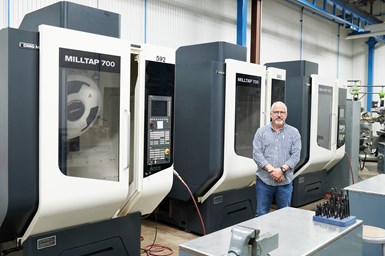
Jim Appleby, Major Tool’s machinist training coordinator, is in charge of teaching technical machining and programming classes to new recruits that cover GD&T to Siemens controls, probing, milling, tapping, turning and basic CNC/shop math. Photo Credit: Tim Schumm, Major Tool
Jim Appleby is Major Tool’s machinist training coordinator in charge of teaching technical machining and programming classes to new recruits — classes that cover everything from geometric dimensioning and tolerancing (GD&T) to Siemens controls, probing, milling, tapping, turning and basic CNC/shop math. Class sizes are typically limited to six students or fewer, all of whom receive both standard classroom training as well as hands-on instruction using DMG MORI Milltap 700s and several CNC lathes — machine tools Major Tool has dedicated for the purposes of training alone.
Students who show potential, Appleby says, will complete their training and progress to a mentorship program hosted by a veteran machinist. The trainee and mentor each are paid for their efforts — $20 an hour for the trainee and an undisclosed amount of extra pay for the mentor. The apprenticeship can last anywhere from three to six months, during which the teacher and student are tied at the hip, Griffith says.
“We're trying to do what naturally might take four or five years for that person to improve their skill level, and reduce that to a matter of months,” he adds. “It's more than learning a piece of equipment. Mentoring is about teaching you how to make a part and how to be a machinist.”
Major Tool’s large-format machining — and its mix of low-volume, high-variety, high-value parts — makes its training and mentoring program all the more imperative, Griffith says. “I feel like we're on the end of the scale where we have to look for the best of the best,” he says. “And you always think that maybe you can work your way through it, that you're going attract people to come here because we're such an awesome place to work, right? And of course that is happening, but the truth of the matter is there's only so many people out there.”
Which brings us to the next imperative:
Tom Cimino, Major Tool’s manufacturing manager for assembly and machining, monitors activity during an automatic inspection routine operation in which a rail-guided vehicle (RGV) feeds loaded pallets into a CMM. This station is part of a multi-machine-tool automated line that aims to bring lights-out machining capability to large parts.
2. Technology & Automation
Major Tool’s roster of large-format CNC machine tools includes those for which the X, Y and Z travel capacities are often measured in feet, not inches. At this scale, even the company’s fastest machines require long cycle times to produce large-format parts. Human interventions that risk introducing errors need to be minimal. Since Major Tool often works with aerospace-grade materials like titanium, Hastelloy and Inconel machined from solid blocks, the concern is typically tool degradation which, when coupled with variations in the natural material hardness of a workpiece, can result in painfully expensive scrapped parts. Tool monitoring adaptive control, or TMAC, is one strategy that Major Tool is using to mitigate these risks and decrease cycle times.
Tool monitoring using sensor data has been around for years, but Major Tool is investing in a system that takes it a step further: tool monitoring adaptive control with multi-process monitoring, or TMAC MP. This system from Caron Engineering combines CPU communications from the machine sensors with a power transducer that will stop the machine if it senses tool breakage or a machine crash. The system can also override programmed CNC feed rates to keep a constant, optimum power load on the tool throughout the cut.
Griffith says that adding TMAC capabilities to several of Major Tool’s older machine tools will serve as a complement to previous additions of Siemens controls, as well as in-process part measurement probes to reduce the need to stop and restart operations.
I also witnessed an automatic inspection routine using a rail-guided vehicle (RGV) feeding loaded pallets into a CMM. If the part was out of tolerance, the CMM would have stopped the routine and alerted an operator to troubleshoot. The part that I watched flow through the system was within range, and was automatically loaded back to the RGV and transported to the next station for unloading.
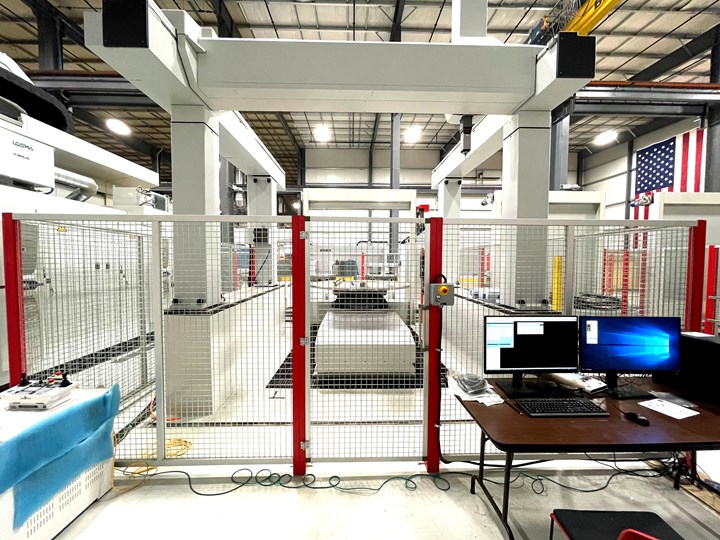
Here is another view of the CMM that is part of the automated machining line. Based on the results of inspection here, the system will either alert an operator or move the part to the next station for unloading. Photo Credit: Tim Schumm, Major Tool
Then there are the machine tools themselves — large-format CNC mills, lathes and high-speed machining centers from Berthiez, Cincinnati Milacron, DMG MORI, Dorries Scharmann Schiess, Giddings & Lewis, Gruppo Parpas, JOBS and Mazak. Griffith says that most of Major Tool’s older machines have been retrofitted not only with Siemens 840D controls, but also new drives, motors, sensors and in-process inspection probes.
Two of the company’s latest machine tools needed no such intervention. Major Tool’s two Gruppo Parpas high-speed machining centers — an XS 10.4 and an XS 20.4, both five-axis gantry mills with X-axis travel capacity of 32.8 feet and 65.6 feet, respectively — were first spotted by Griffith and his team at the International Manufacturing Technology Show (IMTS) in 2018. “We saw their sign that said, ‘Most Accurate Gantry Mill in the World,’ Griffith recalls. Whether true or not, it was a conversation starter. “And after talking to Parpas, we walked away with a deal to buy a 20-meter machine.”
Several features on the Parpas machines suit Major Tool’s needs, including not only the machines’ size but also the exchangeable heads with a universal five-axis high speed milling head option. But these machines’ claim to fame — the core reason why they can hold tolerances within a few thousandths of an inch true position across massive dimensions — are its system-wide environmental controls inside the work envelope.
While studying the Parpas machines at Major Tool, I spotted Parpas America’s operations manager of territory sales, Thomas Hagey, one of the people who first met Griffith’s team at IMTS back in 2018. Hagey worked with Major Tool over the course of a year during the installation of the Parpas equipment in 2020 — the height of lockdown restrictions during the pandemic. Installation took nearly a year, not only to dig a 64-inch foundation 30 meters long and fill it with concrete, but also to convince members of the Italian consulate as well as Indiana U.S. senators to allow a team of Parpas engineers to travel from Italy to the United States during Covid.
Hagey explained that the accuracy achieved by the Parpas machines is due largely to the environmentally controlled work envelope. Everything from the columns to the cross-rails to the machining heads themselves are air cooled. This environmental control keeps each component from expanding and shrinking, even amid high levels of kinetic energy generated by extremely long cutting passes.
But being mindful of the “environment" is a consideration that applies to far more than just machining. And this brings us to our final area of commitment:
3. People
A fourth plant at Major Tool is about people rather than parts or equipment. The plant is named ‘4U,’ a nod to the benefits, services, and human-focused spaces inside. You can view one of the company’s perks in a YouTube video posted on the its website. The video features a shiny new Cadillac rolling slowly down an aisle flanked by cheering friends and colleagues — a gift for an employee on his 50th work anniversary. Investing to care for and appreciate people is a vital enabler to culture and retention.
Major Tool’s building ‘4U’ is as much a place for actual human resources as it is for its HR department. Here, employees can visit the company’s full-time staff doctor. They can exercise in a fully equipped gym. They can receive training from Jim Appleby. And they can gaze upon “the board,” a giant homage to Major Tool’s longer-serving employees (and the company’s retention rate), with photos arranged according to how long each person has served, from 1 to 50 years.
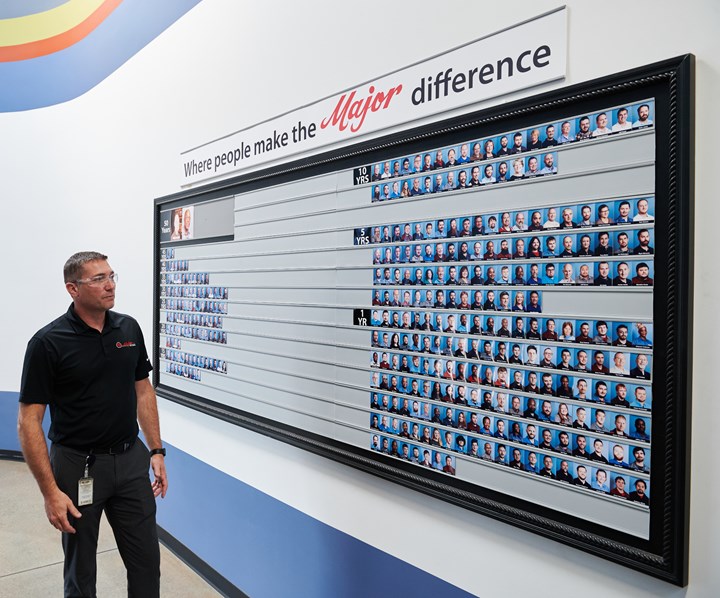
Major Tool president Mike Griffith in front of the company’s ‘big board’ located in building 4U — an homage to employees’ loyalty and service to the company. Photo Credit: Tim Schumm, Major Tool
After our visit, what was clear was that machine shops and contract manufacturers like Major Tool are in a deeply transitional phase long in the making. The systemized processes that Major Tool is creating still demand training and technical knowledge, but they are built to be less reliant on humans making perfect choices at every turn. Still, just because a new systemized machining process may rely on adaptive controls and automation, it doesn’t mean that Major Tool wouldn’t benefit by having a deeper pool of qualified job seekers.
“We think about the future here a lot,” Griffith says. “And even though we focus on high-end machining, we're struggling with the same thing that all people in manufacturing are struggling with today. Without the right people, it just gets harder when you talk about operating some of the equipment that we do, and working on some of the parts that we do. So we have thought long and hard about how to look at advancements in technology to fill in the void. But for us, it's also about processes — how do we invest more in people and processes to control what's going on in the machine tool? Because that’s what it’s all about.”
Related Content
Addressing Manufacturing Challenges with Automation
GrayMatter Robotics’ Physical AI robotic cells for manufacturing offer immediate impact and results.
Read MoreAutomation is for Everyone
Not just for large shops, automation can help even the smallest shops solve labor challenges and become more profitable and efficient.
Read MoreAerospace Shop Thrives with Five-Axis, AI and a New ERP
Within three years, MSP Manufacturing has grown from only having three-axis mills to being five-axis capable with cobots, AI-powered programming and an overhauled ERP. What kind of benefits do these capabilities bring? Find out in our coverage of MSP Manufacturing.
Read MoreMedical Shop Performs Lights-Out Production in Five-Axes
Moving to five-axis machining enabled this shop to dramatically reduce setup time and increase lights-out capacity, but success relied on the right combination of workholding and automation.
Read MoreRead Next
Meet Colossus: An Inside Look at One of the Largest Five-Axis Machining Centers in the U.S.
My behind-the-scenes tour on the shop floor of Baker Industries began and ended with its Emco Mecof PowerMill, one of the biggest five-axis machining centers in the United States. The tour also shed light on the company’s highly aggressive approach to new equipment purchases.
Read MoreOEM Tour Video: Lean Manufacturing for Measurement and Metrology
How can a facility that requires manual work for some long-standing parts be made more efficient? Join us as we look inside The L. S. Starrett Company’s headquarters in Athol, Massachusetts, and see how this long-established OEM is updating its processes.
Read More
















